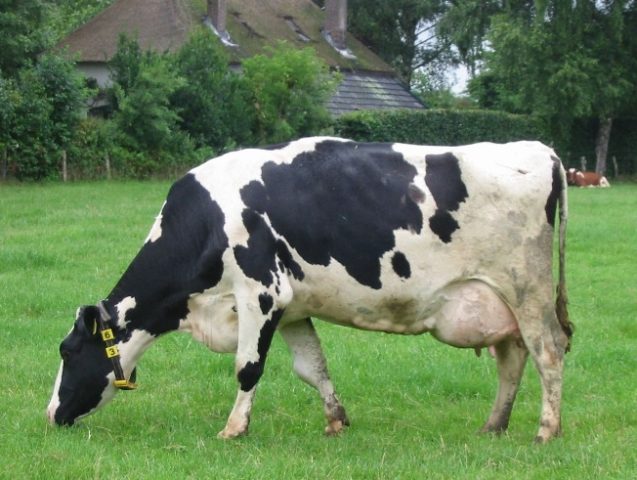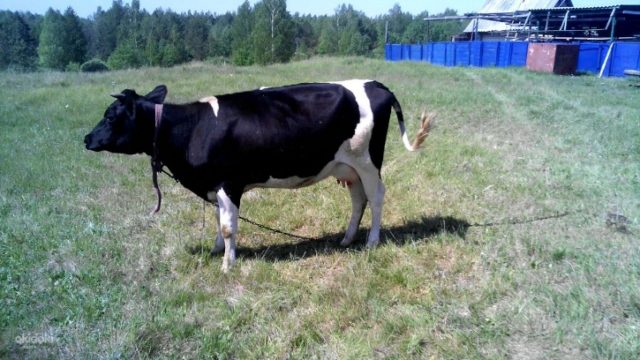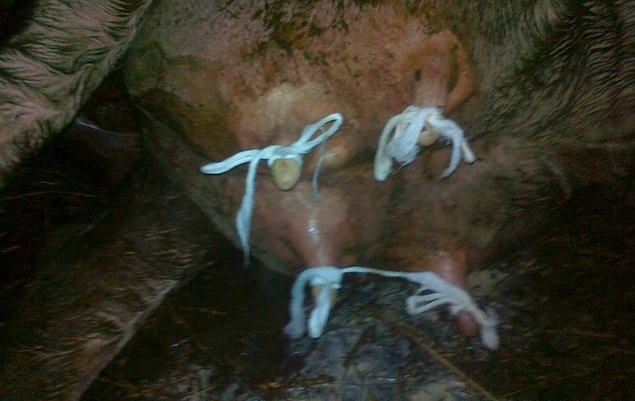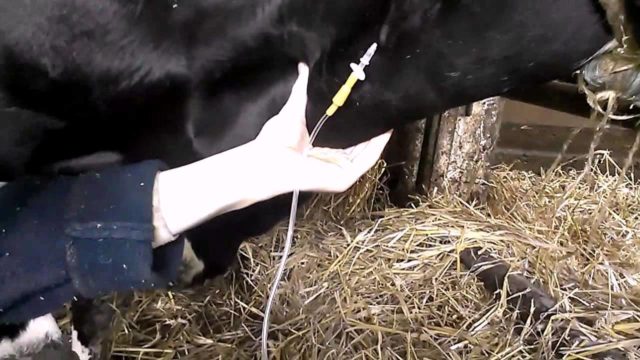Content
Postpartum paresis in cows has long been the scourge of cattle breeding. Although today the situation has not improved much. The number of animals dying is less, thanks to the found methods of treatment. But the number of cases of the disease has hardly changed, since the etiology of postpartum paresis has not yet been properly studied.
What is this disease in cattle "postpartum paresis"
The disease has a lot of other names, scientific and not very. Postpartum paresis can be called:
- milk fever;
- maternity paresis;
- postpartum hypocalcemia;
- childbirth coma;
- hypocalcemic fever;
- coma of dairy cows;
- labor apoplexy.
With a coma, folk art went too far, and postpartum paresis was called apoplexy because of the similarity of symptoms. In those days when it was not possible to make an accurate diagnosis.
According to modern concepts, it is a neuroparalytic disease. Postpartum paresis affects not only the muscles, but also the internal organs. Postpartum hypocalcemia begins with general depression, later turning into paralysis.
Usually, paresis in a cow develops after calving within the first 2-3 days, but there are also options. Atypical cases: development of postpartum paralysis during calving or 1-3 weeks before it.
Etiology of maternity paresis in cattle
Due to the wide variety of case histories of postpartum paresis in cows, the etiology has so far remained unclear. Research veterinarians are trying to relate the clinical signs of milk fever to possible causes of the disease. But they do it badly, since theories do not want to be confirmed either by practice or by experiments.
The etiological prerequisites for postpartum paresis include:
- hypoglycemia;
- increased insulin in the blood;
- violation of carbohydrate and protein balances;
- hypocalcemia;
- hypophosphoremia;
- hypomagnesemia.
The last three are thought to be caused by the stress of the hotel. A whole chain was built from the release of insulin and hypoglycemia. Perhaps, in some cases, it is the increased work of the pancreas that serves as the trigger for postpartum paresis. The experiment showed that when healthy cows were administered 850 units. insulin in animals, a typical picture of postpartum paresis develops. After the introduction of 40 ml of a 20% glucose solution to the same individuals, all symptoms of milk fever quickly disappear.
The second version: increased release of calcium at the beginning of milk production. A dry cow needs 30-35 g of calcium per day to maintain its vital functions. After calving, colostrum can contain up to 2 g of this substance. That is, when producing 10 liters of colostrum, 20 g of calcium will be removed from the cow's body every day. As a result, a deficit arises, which will be replenished within 2 days. But these 2 days still have to be lived. And it is during this period that the development of postpartum paresis is most likely.

High-yielding livestock are most susceptible to postpartum hypocalcemia
The third version: inhibition of the work of the parathyroid glands due to general and generic nervous excitement. Because of this, an imbalance in protein and carbohydrate metabolism develops, and there is also a lack of phosphorus, magnesium and calcium. Moreover, the latter may be due to the lack of the necessary elements in the feed.
The fourth option: the development of postpartum paresis due to overstrain of the nervous system. This is indirectly confirmed by the fact that the disease is successfully treated according to the Schmidt method, blowing air into the udder. The cow's body does not receive any nutrients during treatment, but the animal recovers.
Causes of postpartum paresis
Although the mechanism that triggers the development of the disease has not been established, external causes are known:
- high milk productivity;
- concentrate type of food;
- obesity;
- lack of exercise.
The most susceptible to postpartum paresis are cows at their peak of productivity, that is, at the age of 5-8 years. First-calf heifers and low-productivity animals rarely get sick. But they also have cases of the disease.
Symptoms of paresis in cows after calving
Postpartum paralysis can occur in 2 forms: typical and atypical. The second is often not even noticed, it looks like a slight malaise, which is attributed to the fatigue of the animal after calving. In the atypical form of paresis, a wobbly gait, muscle tremors and a disorder of the digestive tract are observed.
The word "typical" speaks for itself. The cow shows all the clinical signs of postpartum paralysis:
- oppression, sometimes on the contrary: excitement;
- refusal of feed;
- trembling of certain muscle groups;
- a decrease in the general body temperature to 37 ° C and less;
- the local temperature of the upper part of the head, including the ears, is lower than the general one;
- the neck is bent to the side, sometimes an S-shaped bend is possible;
- the cow cannot stand up and lies on the chest with bent legs;
- eyes are wide open, unblinking, pupils are dilated;
- the paralyzed tongue hangs down from the open mouth.
Since, due to postpartum paresis, the cow cannot chew and swallow food, concomitant diseases develop:
- tympany;
- bloating;
- flatulence;
- constipation.
If the cow is unable to heat up, the manure is deposited in the colon and rectum. The liquid from it is gradually absorbed into the body through the mucous membranes and the manure hardens / dries up.
Is there paresis in first-calf heifers
First-calf heifers can also develop postpartum paresis. They rarely show clinical signs, but 25% of animals have blood calcium levels below normal.
In first-calf heifers, milk fever usually manifests itself in postpartum complications and displacement of internal organs:
- inflammation of the uterus;
- mastitis;
- detention of the placenta;
- ketosis;
- displacement of the abomasum.
Treatment is carried out in the same way as for adult cows, but it is much more difficult to keep a first calf, since she usually does not have paralysis.

Although the risk of postpartum paralysis is lower in first-calf heifers, this probability cannot be discounted.
Treatment of paresis in a cow after calving
Postpartum paresis in a cow is rapid and treatment should be started as soon as possible. Two methods are most effective: intravenous injections of a calcium preparation and the Schmidt method, in which air is blown into the udder. The second method is the most common, but you need to know how to use it. Both methods have their own advantages and disadvantages.
How to treat maternity paresis in a cow according to the Schmidt method
The most popular method of treating postpartum paresis today. It does not require on-farm storage of calcium supplements or intravenous injection skills. Helps a significant number of diseased queens.The latter shows well that a lack of glucose and calcium in the blood is perhaps not the most common cause of paresis.
For the treatment of postpartum paralysis according to the Schmidt method, an Evers apparatus is required. It looks like a rubber hose with a milk catheter at one end and a blower at the other. The tube and bulb can be taken from an old blood pressure monitor. Another option for "building" the Evers apparatus in the field is a bicycle pump and a milk catheter. Since there is no time to waste in postpartum paresis, the original Evers apparatus was improved by Zh. A. Sarsenov. In the modernized device, 4 tubes with catheters extend from the main hose. This allows 4 udder lobes to be pumped at once.
Mode of application
It will take several people to get the cow into the desired dorsal-lateral position. The average weight of an animal is 500 kg. Milk is removed and disinfected with alcohol tops of the nipples. Catheters are carefully inserted into the canals and air is slowly pumped in. It has to affect the receptors. With a quick introduction of air, the impact is not as intense as with a slow one.
The dosage is determined empirically: the folds on the udder skin should straighten out, and a tympanic sound should appear by tapping the fingers on the mammary gland.
After blowing in air, the tops of the nipples are lightly massaged so that the sphincter contracts and does not allow air to pass through. If the muscle is weak, the nipples are tied with a bandage or soft cloth for 2 hours.

It is impossible to keep the nipples tied for longer than 2 hours, they can die off
Sometimes the animal rises after 15-20 minutes after the procedure, but more often the healing process is delayed for several hours. Muscle tremors can be observed in the cow before and after getting to her feet. Recovery can be considered the complete disappearance of signs of postpartum paresis. The recovered cow begins to eat and move around calmly.
Cons of the Schmidt method
The method has quite a few drawbacks, and it is not always possible to apply it. If insufficient air has been pumped into the udder, there will be no effect. With an excess or too rapid pumping of air in the udder, subcutaneous emphysema occurs. They disappear over time, but damage to the parenchyma of the mammary gland reduces the cow's performance.
In most cases, a single blowing of air is sufficient. But if there is no improvement after 6-8 hours, the procedure is repeated.

Treatment of postpartum paresis using the Evers apparatus is the simplest and least expensive for a private owner
Treatment of postpartum paresis in a cow with intravenous injection
Used in the absence of an alternative in severe cases. Intravenous infusion of a calcium preparation instantly increases the concentration of the substance in the blood several times. The effect lasts 4-6 hours. Immobilized cows are life-saving therapy.
But intravenous injections cannot be used to prevent postpartum paresis. If the cow does not show clinical signs of the disease, a short-term change from calcium deficiency to its excess interrupts the work of the regulatory mechanism in the animal's body.
After the effect of artificially injected calcium wears off, its level in the blood will drop significantly. The experiments carried out showed that during the next 48 hours the level of the element in the blood of "calcified" cows was much lower than in those who did not receive an injection of the drug.

Intravenous calcium requires a drip
Calcium subcutaneous injection
In this case, the drug is absorbed into the blood more slowly, and its concentration is lower than with intravenous infusion. Due to this, subcutaneous injection has less effect on the work of the regulatory mechanism.But for the prevention of maternity paresis in cows, this method is also not used, since it still violates the balance of calcium in the body. To a lesser extent.
Subcutaneous injections are recommended for the treatment of cows with prior paralysis or uterus with mild clinical signs of postpartum paresis.
Prevention of paresis in cows before calving
There are several ways to prevent postpartum paralysis. But it should be borne in mind that, although some measures reduce the risk of paresis, they increase the likelihood of developing subclinical hypocalcemia. One of these risky ways is to deliberately limit the amount of calcium during the dry period.
Calcium deficiency in dead wood
The method is based on the fact that even before calving, a lack of calcium in the blood is artificially created. The expectation is that the cow's body will begin to extract metal from the bones and by the time of calving, it will react more quickly to the increased need for calcium.
To create a deficiency, the uterus should receive no more than 30 g of calcium per day. And this is where the problem arises. This figure means that the substance should be no more than 3 g in 1 kg of dry matter. This figure cannot be obtained with a standard diet. Feed containing 5-6 g of metal in 1 kg of dry matter is already considered "poor in calcium". But even this amount is too much to trigger the necessary hormonal process.
To overcome this problem, in recent years, special supplements have been developed that bind calcium and prevent it from being absorbed. Examples of such additives include the silicate mineral zeolite A and conventional rice bran. If a mineral has an unpleasant taste and animals can refuse to eat food, then the bran does not affect the taste. You can add them up to 3 kg per day. By binding calcium, the bran is at the same time protected from degradation in the rumen. As a result, they "go through the digestive tract."

Calcium is excreted from the body of cattle along with rice bran
The use of "acidic salts"
The development of postpartum paralysis can be influenced by the high content of potassium and calcium in feed. These elements create an alkaline environment in the animal's body, which makes it difficult for the release of calcium from the bones. Feeding a specially formulated mixture of anionic salts "acidifies" the body and facilitates the release of calcium from the bones.
The mixture is given within the last three weeks along with vitamin and mineral premixes. As a result of the use of "acidic salts", the calcium content in the blood with the onset of lactation does not decrease as quickly as without them. Accordingly, the risk of developing postpartum paralysis is also reduced.
The main drawback of the mixture is its disgusting taste. Animals may refuse to eat foods containing anionic salts. It is necessary not only to mix the supplement evenly with the main feed, but also try to reduce the potassium content in the main diet. Ideally, to a minimum.
Vitamin D injections
This method can both help and harm. Vitamin injection reduces the risk of developing postpartum paralysis, but it can provoke subclinical hypocalcemia. If it is possible to do without a vitamin injection, it is better not to do it.
But if there is no other way out, it must be borne in mind that vitamin D is injected only 10-3 days before the planned calving date. Only during this interval can the injection have a positive effect on the concentration of calcium in the blood. The vitamin enhances the absorption of metal from the intestines, although there is still no increased need for calcium during the injection.
But due to the artificial introduction of vitamin D in the body, the production of its own cholecalciferol slows down. As a result, the normal mechanism of calcium regulation fails for several weeks, and the risk of developing subclinical hypocalcemia increases 2-6 weeks after the injection of vitamin D.
Conclusion
Postpartum paresis can affect almost any cow. A complete diet reduces the risk of illness, but does not exclude it. At the same time, there is no need to be zealous with prevention before calving, since here you will have to balance on the verge between milk fever and hypocalcemia.








